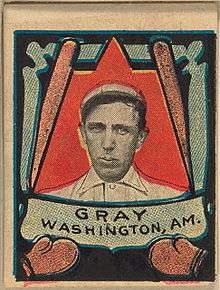Dolly Gray (baseball)
| Dolly Gray | |||
|---|---|---|---|
 | |||
| Pitcher | |||
|
Born: December 4, 1878 Houghton, Michigan | |||
|
Died: April 4, 1956 (aged 77) Yuba City, California | |||
| |||
| MLB debut | |||
| April 13, 1909, for the Washington Senators | |||
| Last MLB appearance | |||
| September 29, 1911, for the Washington Senators | |||
| MLB statistics | |||
| Earned run average | 3.52 | ||
| Win–loss record | 15-51 | ||
| Strikeouts | 213 | ||
| Teams | |||
| |||
William Denton "Dolly" Gray (December 4, 1878 in Houghton, Michigan – April 4, 1956 in Yuba City, California) was a left-handed professional baseball pitcher who played from 1909 to 1911 for the Washington Senators. One source says he was born in Ishpeming, Michigan.[1]
Before the big leagues
Dolly Gray began his professional career during or before the 1902 season. In 1902, he pitched for the Los Angeles Angels of the old California League. Following the 1902 season, the Angels joined to the Pacific Coast League, and in 1903 they had one of the greatest seasons in minor league baseball history.[2] Gray went 23–20 with a 3.55 ERA that season. In 1904, Gray went 24–26, in 1905, he went 30–16, in 1906, he went 7–2 (during the 1906 season, Gray and many other West Coast players left to play on the East Coast after the great 1906 San Francisco earthquake),[2] in 1907 he went 32–14 and in 1908 he went 26–11. He played in one game in 1909, winning it. In 1905 and 1907, he led the league in winning percentage.
For his success in the minors, Gray is a member of the Pacific Coast League Hall of Fame.
Major league baseball
A 30-year-old rookie, Gray made his major league debut on April 13, 1909. He made 36 appearances in his rookie season, starting 26 of those games. He we 5–19 with 19 complete games. That year, he led the league in earned runs allowed (87), was third in losses, seventh in walks allowed (77) and eighth in appearances. Gray gave up Tris Speaker's first big league home run on May 3 of that year,[3] and on August 28 of that year, he set the major league record for most walks allowed in an inning, when he walked eight batters in the second inning. He also set the record for most consecutive walks in an inning, when he walked seven batters in a row. In total, Gray allowed 11 walks that game, giving up six runs and earning the loss in the process. Had he had better control, he may very well have won the game – he threw a one-hitter.[4]
In 1910, Gray went 8–19 with a 2.63 ERA. He was second in the league in losses that year, fifth in wild pitches (9), ninth in earned runs allowed (67) and ninth in hit batsmen (10).
On April 12, 1911, Gray threw the very first pitch in Griffith Stadium history. He also won the game that day, beating opposing pitcher Smoky Joe Wood. That would be one of only two wins for Gray in 1912 – overall that season, he went 2–13 with a 5.06 ERA. His ten wild pitches that season were fourth most in the league, and his ten games finished were eighth most in the league. Gray played in his final major league game on September 29, 1911.
Gray went 15–51 with a 3.52 ERA in his three-year career. His .227 winning percentage is one of the worst all-time among pitchers with at least 50 career decisions. As a batter, Gray was pretty solid for a pitcher – he hit .202 in 218 big league at bats.
Statistically, Gray is most similar to Blondie Purcell, according to the Similarity Scores at Baseball-Reference.com.
Post-big league career
Following his major league career, Gray pitched in the Pacific Coast league from 1912 to 1913, retiring after the 1913 season.[2] He played for the Vernon Tigers and Oakland Oaks in that time.[5]
Following his death, he was buried in Sutter Cemetery in Sutter, California.[6]
In 2008, Gray was inducted into the Pacific Coast League Hall of Fame, along with Wheezer Dell, Casey Stengel and Lee Susman.[5]
The nickname
Gray got his nickname Dolly from the 19th century song Nellie Gray, composed by Benjamin Hanby. One line in the song goes darling Nellie Gray, they have taken you away. His teammates mangled and distorted it darling and it became "Dolly."[2]
Another source says his nickname came from the song Goodbye, Dolly Gray.[7]
Notes
- ↑ Snelling, D. (1995). The Pacific Coast League: A Statistical History, 1903-1957. McFarland & Company. p. 266. ISBN 9780786400454. Retrieved 2015-08-23.
- 1 2 3 4 "Top 100 Teams | MiLB.com History | The Official Site of Minor League Baseball". web.minorleaguebaseball.com. Retrieved 2015-08-23.
- ↑ "The Ballplayers – Dolly Gray | BaseballLibrary.com". baseballlibrary.com. Retrieved 2015-08-23.
- ↑ Nemec, D.; Zeman, D. (2004). The Baseball Rookies Encyclopedia. Brassey's. p. 91. ISBN 9781574886702. Retrieved 2015-08-23.
- 1 2 "SABR Minor League Committee Blog". Archived from the original on 2008-04-04. Retrieved 2015-08-23.
- ↑ William Denton "Dolly" Gray at Find a Grave
- ↑ "January | 2007 | Coffeyville Whirlwind". coffeyvillewhirlwind.wordpress.com. Retrieved 2015-08-23.
References
- Career statistics and player information from Baseball-Reference, or Baseball-Reference (Minors)
- Baseball Library